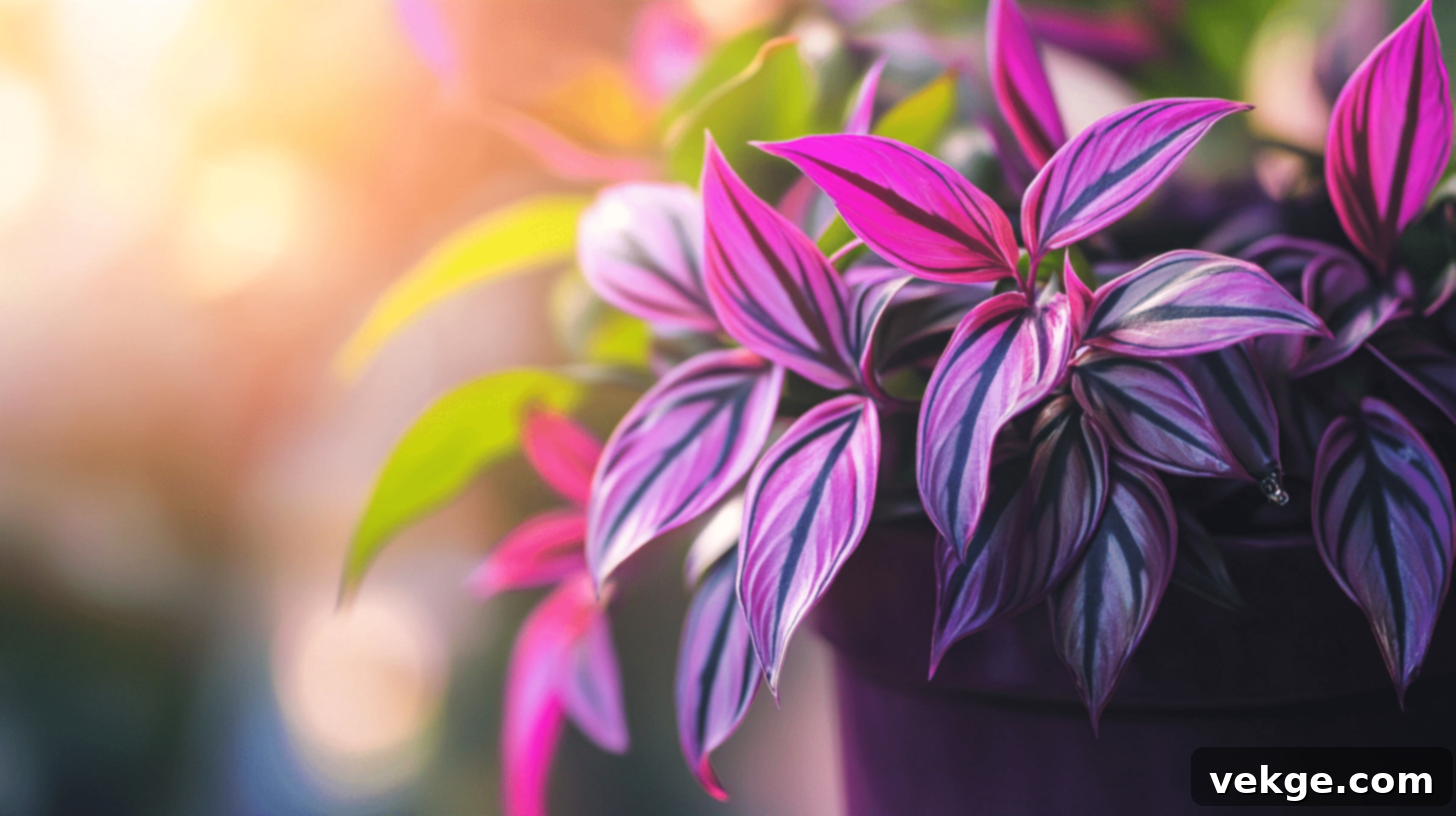Tradescantia Zebrina Care Guide: Unlocking the Vibrant Beauty of the Inch Plant
The Tradescantia zebrina, a magnificent houseplant renowned for its stunning, striped foliage, captivates plant enthusiasts worldwide. Commonly known as the Inch Plant, Spiderwort, or more respectfully, the “Wandering Dude,” this species is celebrated for its rapid growth and remarkably easy care requirements.
Its historical common name, “Wandering Jew,” has unfortunately been linked to harmful stereotypes and has largely been phased out in favor of more inclusive and appropriate alternatives. As such, we embrace names like “Wandering Dude” or simply its scientific name, Tradescantia zebrina.
Originating from the tropical regions of Mexico and Central America, this plant thrives indoors, adapting effortlessly to various home environments. Its cascading stems, adorned with vibrant, heart-shaped leaves displaying shades of deep green, purple, and silver, make it an ideal choice for hanging baskets, elevated shelves, or even as a charming ground cover in warmer climates.
Beyond its striking visual appeal, Tradescantia zebrina contributes to a healthier living space by helping to purify indoor air. Whether you are a beginner taking your first steps into the world of plant care or an experienced green thumb, this resilient and visually appealing species offers both beauty and straightforward maintenance, making it a beloved addition to any indoor garden.
Understanding the Tradescantia Zebrina: The Vibrant Inch Plant
The Tradescantia zebrina, affectionately known as the Inch Plant, is a truly eye-catching houseplant that brings a splash of color to any room. Its distinguishing features include long, flowing stems and uniquely striped leaves that create a mesmerizing visual texture.
Each heart-shaped leaf is a masterpiece of natural design, often displaying a rich tapestry of deep green, vibrant purple, and shimmering silver. The striking stripes are what give the plant its “zebrina” moniker, reminiscent of the distinct patterns found on zebras.
These plants are known for their vigorous and rapid growth, capable of spreading generously. This makes them perfectly suited for hanging baskets, where their trailing stems can elegantly cascade downwards, or for placement on high shelves, allowing their foliage to create a dramatic, living curtain.
Native to the lush, warm environments of Mexico and parts of Central America, Tradescantia zebrina naturally thrives as a ground cover in shaded woodlands and open fields. In its wild habitat, it often weaves its way around other plants, using them for gentle support as it spreads. This natural adaptability translates beautifully to indoor settings, where it tolerates a range of conditions with remarkable resilience.
Its forgiving nature makes Tradescantia zebrina an excellent choice for both novice plant parents and those with busy lifestyles. Even if you occasionally forget to water, this robust plant typically bounces back, making it a low-stress, high-reward addition to your indoor plant collection.
Exploring Varieties and Related Species of Tradescantia
The Tradescantia zebrina is just one member of a diverse and beautiful plant family, the genus Tradescantia. While many varieties share similar characteristics, subtle differences in leaf coloration, pattern, and growth habit make each one uniquely charming. Let’s delve into some popular types that can brighten up your home.
Distinct Types of Tradescantia Zebrina
Within the Tradescantia zebrina species itself, there are several cultivars, each offering a slightly different visual appeal:
1. Tradescantia Zebrina ‘Violet’
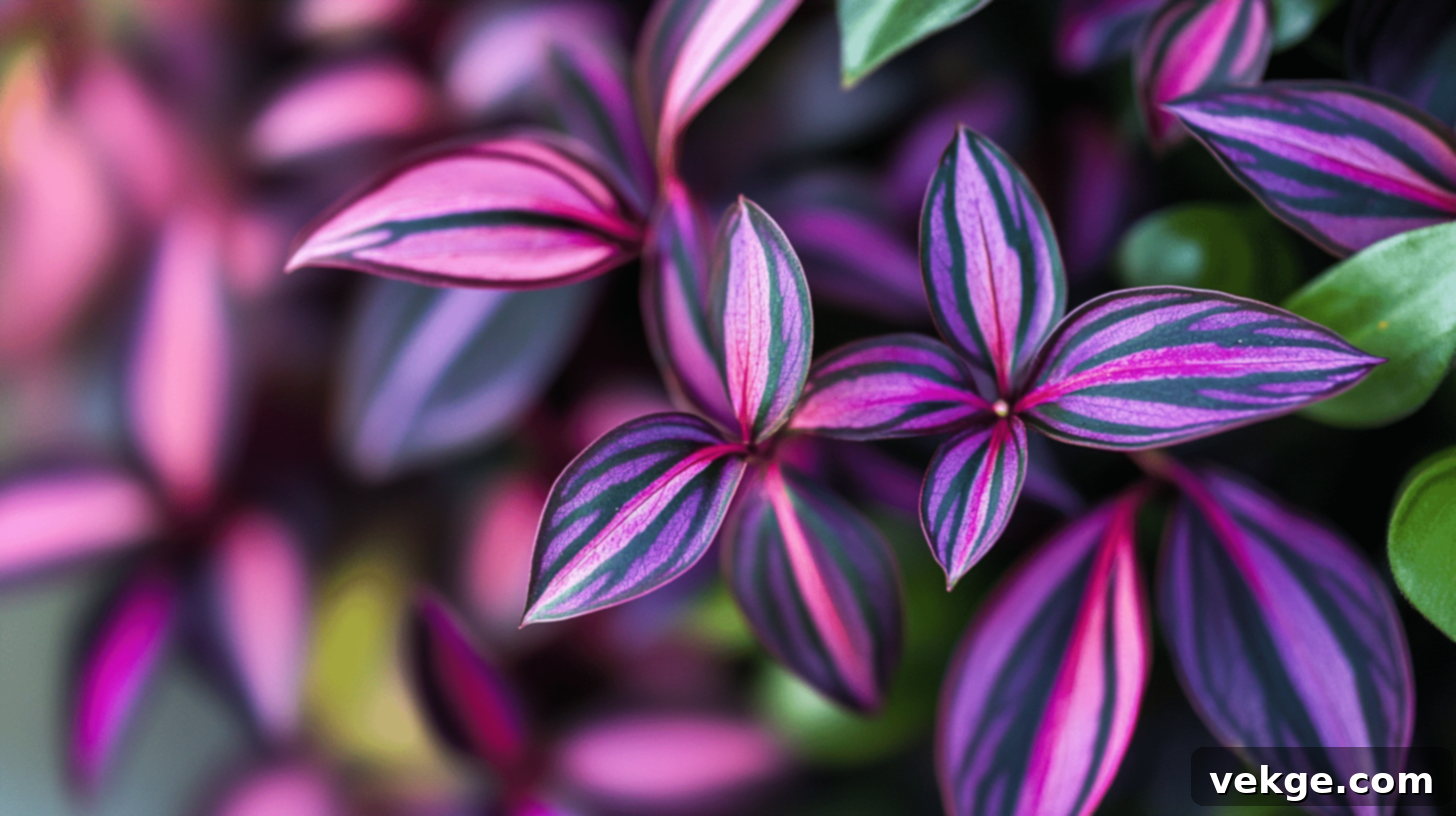
This striking cultivar features leaves with prominent deep purple and green stripes on the upper surface, beautifully contrasted by an intense, vibrant purple on the underside. Its strong coloration makes it a standout. Like other Tradescantia zebrina, it’s a vigorous grower, making it ideal for creating lush, overflowing hanging displays.
2. Tradescantia Fluminensis ‘Quicksilver’
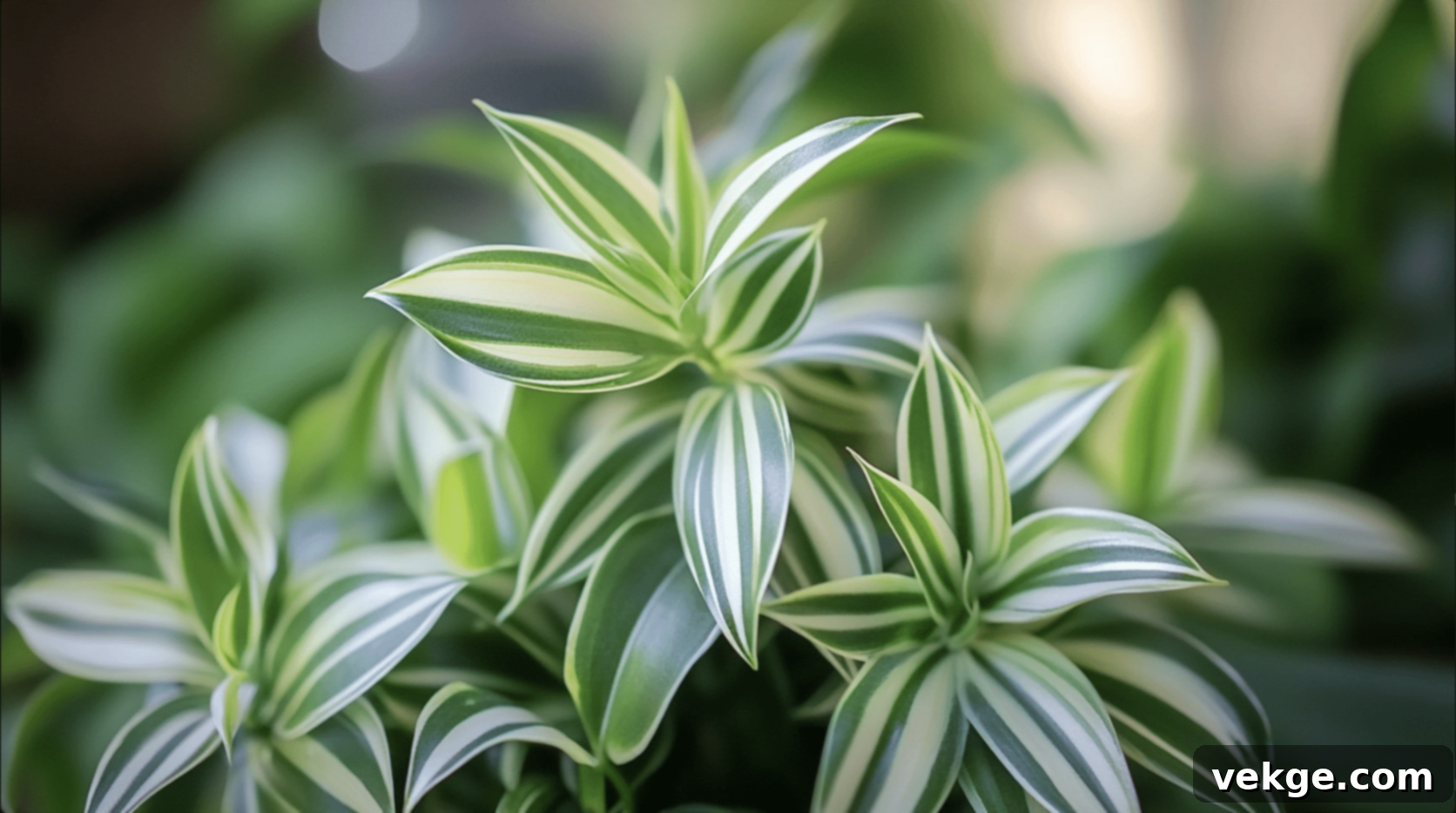
While often grouped with Tradescantia zebrina due to similar care and appearance, ‘Quicksilver’ is technically a cultivar of Tradescantia fluminensis. It stands out with its bright green leaves adorned with crisp white stripes, giving it a fresh and airy look. This variety thrives indoors and can significantly brighten a space with its lighter, variegated foliage, offering a lovely contrast to the darker purples.
3. Tradescantia pallida ‘Purple Heart’
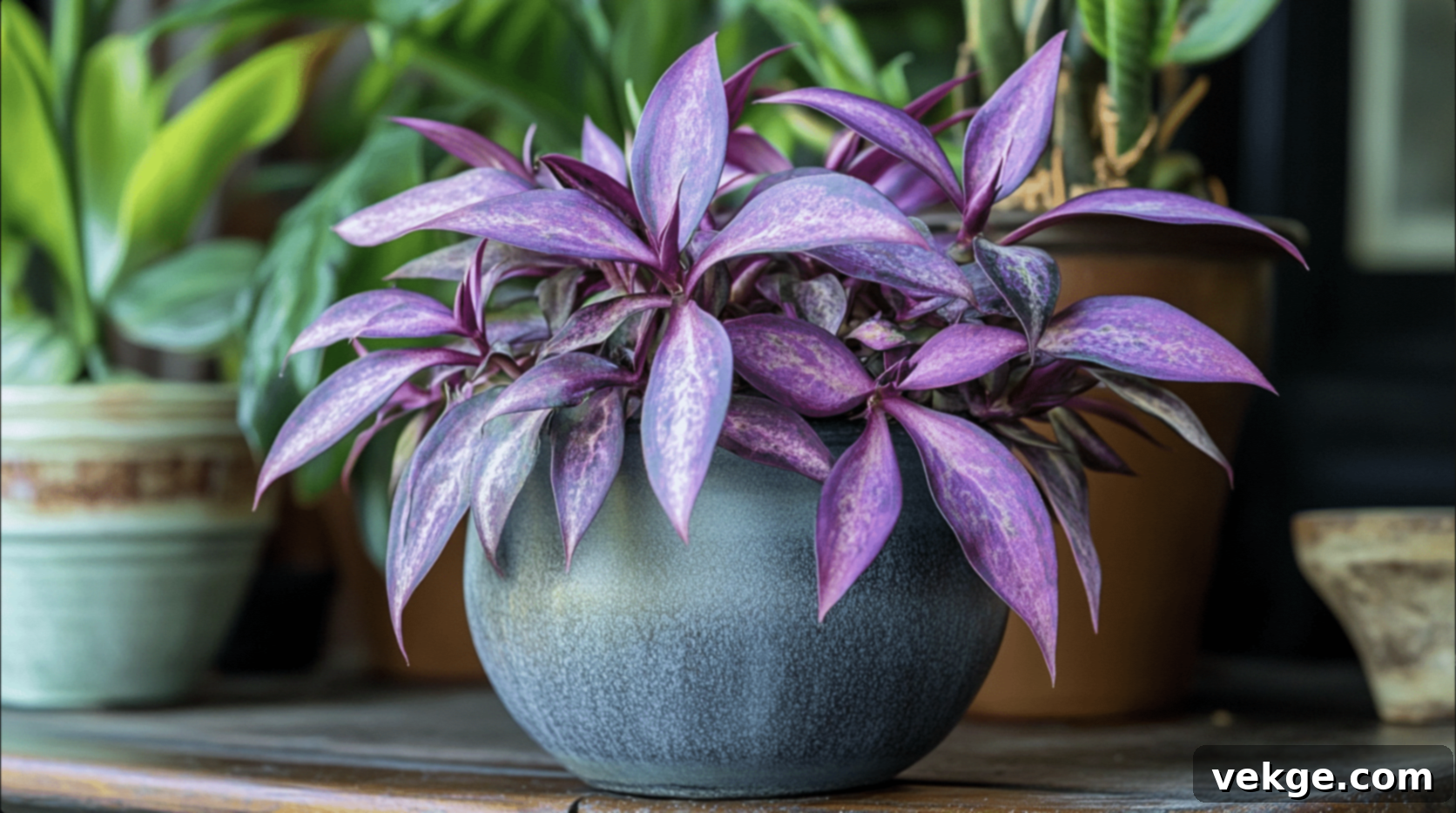
As its name boldly suggests, the ‘Purple Heart’ is characterized by its intensely purple foliage. The leaves are typically longer and more pointed than those of Tradescantia zebrina, and the entire plant exudes a rich, deep hue. It can also produce small, delicate pink or purple flowers, adding another layer of charm. This robust variety is often used outdoors in warm climates but makes a stunning indoor specimen as well.
Other Notable Tradescantia Varieties
Beyond these primary types, the world of Tradescantia offers even more dazzling options:
- ‘Quadricolor’: A truly multi-faceted plant, ‘Quadricolor’ displays leaves splashed with a fascinating blend of four colors – typically green, purple, pink, and white. This kaleidoscope of hues makes it a highly sought-after variety for adding intricate detail to plant arrangements.
- ‘Red Gem’: For those who love deep, rich tones, ‘Red Gem’ is a perfect choice. Its leaves are predominantly a striking red or a profound deep purple, providing a dramatic accent.
- ‘Silver Plus’: This cultivar lives up to its name by featuring an even more pronounced silver sheen on its leaves compared to the standard Tradescantia zebrina, making it sparkle in the right light.
All these Tradescantia varieties share the common traits of being easy to grow and maintain. Their vibrant colors and characteristic trailing stems can effortlessly transform any space, injecting life and dynamic beauty into your home environment.
The History and Ethical Considerations of the Name ‘Wandering Jew’

For many years, Tradescantia zebrina was widely known by the common name ‘Wandering Jew.’ However, this name carries a problematic history rooted in harmful stereotypes, and as a result, many in the plant community have actively moved away from using it. Understanding the origins of this name and its negative connotations is crucial for fostering an inclusive and respectful gardening culture.
The History Behind the Name ‘Wandering Jew’
The name ‘Wandering Jew’ is derived from an ancient European folk legend that emerged in the Middle Ages. This legend, which is not found in biblical texts, tells the story of a man who supposedly mocked Jesus on his way to crucifixion and was consequently cursed to wander the earth until the Second Coming. This figure became a symbol of eternal exile and suffering.
The plant itself received this name due to its vigorous, sprawling growth habit; its stems readily “wander” and root in new places, allowing it to spread quickly and widely. Unfortunately, this botanical characteristic became an unwitting connection to a myth that has historically been used to fuel anti-Semitic narratives, portraying Jewish people as perpetual outsiders or transient figures.
Why We Are No Longer Using the Name
In contemporary society, there is a growing awareness of how language can perpetuate prejudice and cause harm. The term ‘Wandering Jew’ is inextricably linked to centuries of anti-Semitic stereotypes and persecution. Its continued use, even if unintentional, can be deeply offensive and exclusionary to Jewish people.
As part of a broader movement towards more inclusive and ethical language in horticulture, many plant enthusiasts, nurseries, and botanical organizations have made a conscious decision to discontinue the use of this name. It’s an important step in acknowledging historical harms and ensuring that the joy of gardening is accessible and welcoming to everyone, free from associations with bigotry.
Instead, we encourage the use of the plant’s scientific name, Tradescantia zebrina, which is precise and neutral. Alternatively, several respectful and descriptive common names are widely adopted:
- Inch Plant: This name refers to how quickly it grows and spreads, often putting on an “inch” of growth in a short period.
- Wandering Dude: A playful and respectful adaptation that retains the “wandering” aspect of its growth habit without the problematic historical baggage.
- Spiderwort: A name given to many plants in the Tradescantia genus, referring to the delicate, spider-like appearance of their flowers or roots.
By consciously choosing these alternative names, we help to create a more compassionate and understanding environment for all plant lovers, celebrating the plant’s beauty without inadvertently causing offense.
Nurturing Your Inch Plant: Essential Tips for Success
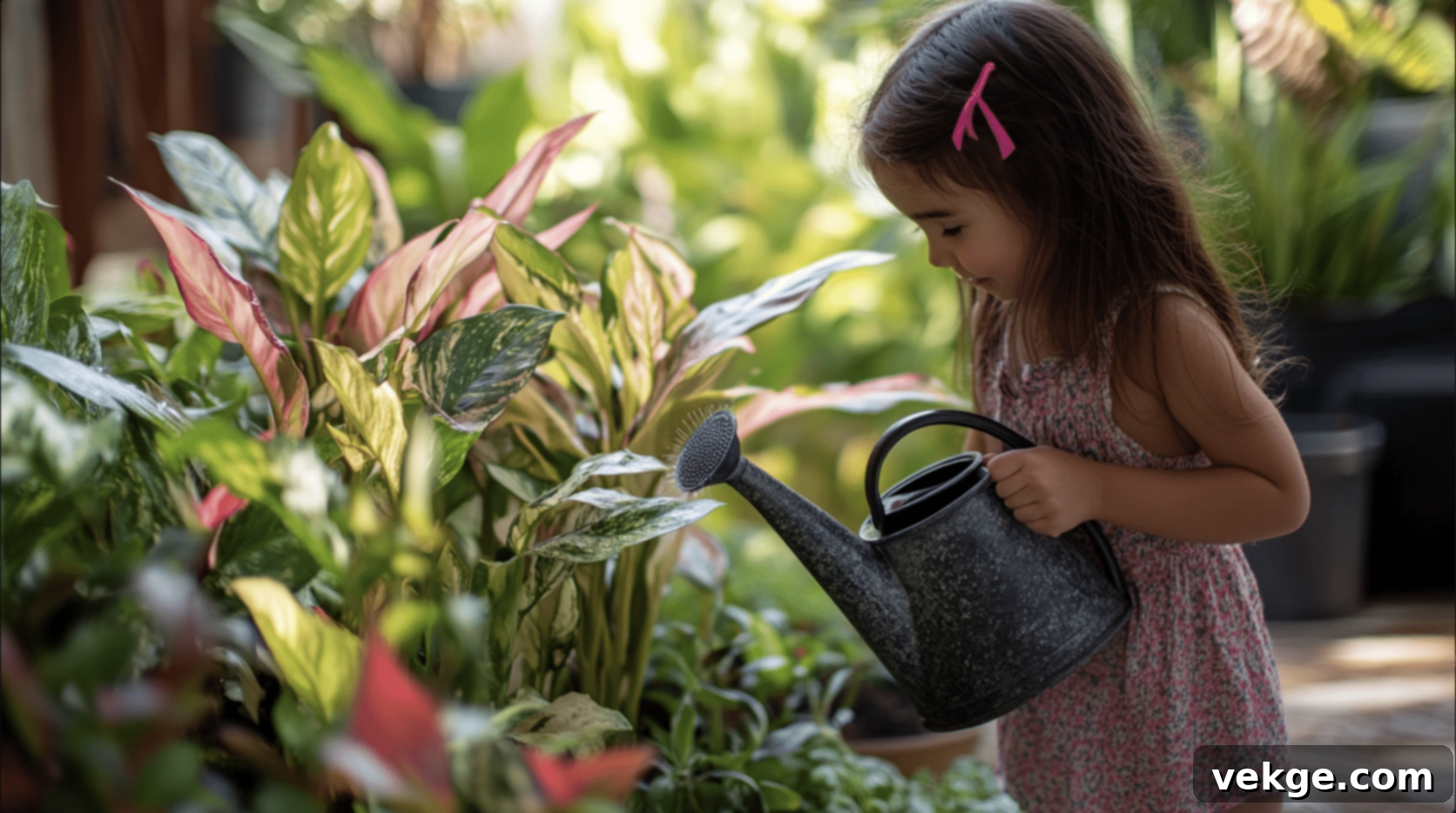
Caring for your Tradescantia zebrina is wonderfully straightforward, making it an ideal choice for both beginners and seasoned plant enthusiasts. Follow these simple guidelines to ensure your Inch Plant thrives and displays its most vibrant colors.
- Light: Your Tradescantia zebrina adores bright, indirect light. A spot near a window that faces east or west, or a north-facing window, is often ideal. While it tolerates some shade, insufficient light can cause the leaves to lose their vivid stripes and become dull or leggy. Conversely, direct, intense sunlight can scorch the delicate foliage, leading to faded colors and crispy edges. Aim for a location where it receives plenty of ambient brightness without harsh, unfiltered rays.
- Water: Consistency is key with watering. Water your plant thoroughly when the top 1-2 inches of soil feel dry to the touch. It’s crucial to avoid overwatering, as sitting in soggy soil can quickly lead to root rot, a common killer of houseplants. Ensure your pot has drainage holes. In contrast, prolonged dryness will cause the leaves to become limp and crispy. Reduce watering frequency during the cooler autumn and winter months when the plant’s growth slows down.
- Soil: Well-draining soil is paramount for the health of your Inch Plant. A standard, good-quality potting mix augmented with materials like perlite, coarse sand, or small orchid bark will provide the necessary aeration and drainage. This ensures that water flows through effectively, preventing it from becoming waterlogged around the roots.
- Temperature: These tropical beauties thrive in warm, stable conditions. Maintain an indoor temperature between 60°F (15°C) and 80°F (27°C) for optimal growth. They are sensitive to cold drafts and extreme temperature fluctuations, so keep them away from open windows during winter or direct air conditioning vents.
- Humidity: As a native of humid climates, Tradescantia zebrina appreciates higher humidity levels. You can provide this by misting the foliage regularly, especially during dry indoor conditions. Alternatively, place the pot on a pebble tray filled with water (making sure the pot itself doesn’t sit directly in the water), or group it with other plants to create a microclimate of increased humidity. A room humidifier can also be a great solution.
- Fertilizer: During the active growing seasons of spring and summer, feed your plant with a balanced liquid houseplant fertilizer diluted to half strength, approximately once a month. This supports its vigorous growth and vibrant foliage. However, cease fertilization during fall and winter, as the plant enters a period of slower growth and doesn’t require additional nutrients.
- Pruning: Regular pruning is essential for maintaining a bushy, full plant and preventing it from becoming leggy and sparse. Simply pinch back or cut off longer stems just above a leaf node. This encourages new growth to branch out from the cut point. The cuttings obtained from pruning can also be easily used for propagation, giving you more plants to enjoy!
- Pests: While generally robust, keep an eye out for common houseplant pests such as spider mites, aphids, and mealybugs. Inspect your plant regularly, especially the undersides of leaves. If you notice any infestations, act quickly. Gently wipe the leaves with a damp cloth, spray with a mild insecticidal soap, or use neem oil to effectively control and eliminate pests.
By following these simple yet effective care steps, your Tradescantia zebrina will flourish, becoming a vibrant and delightful focal point in your home with its dynamic beauty and cascading foliage.
A Simple Guide to Propagating Tradescantia Zebrina
One of the most rewarding aspects of owning a Tradescantia zebrina is how incredibly easy it is to propagate. You can effortlessly create new plants from cuttings, either in water or directly in soil. This makes it perfect for expanding your collection, sharing with friends, or rejuvenating an older plant that has become leggy.
How to Propagate Tradescantia Zebrina in Water
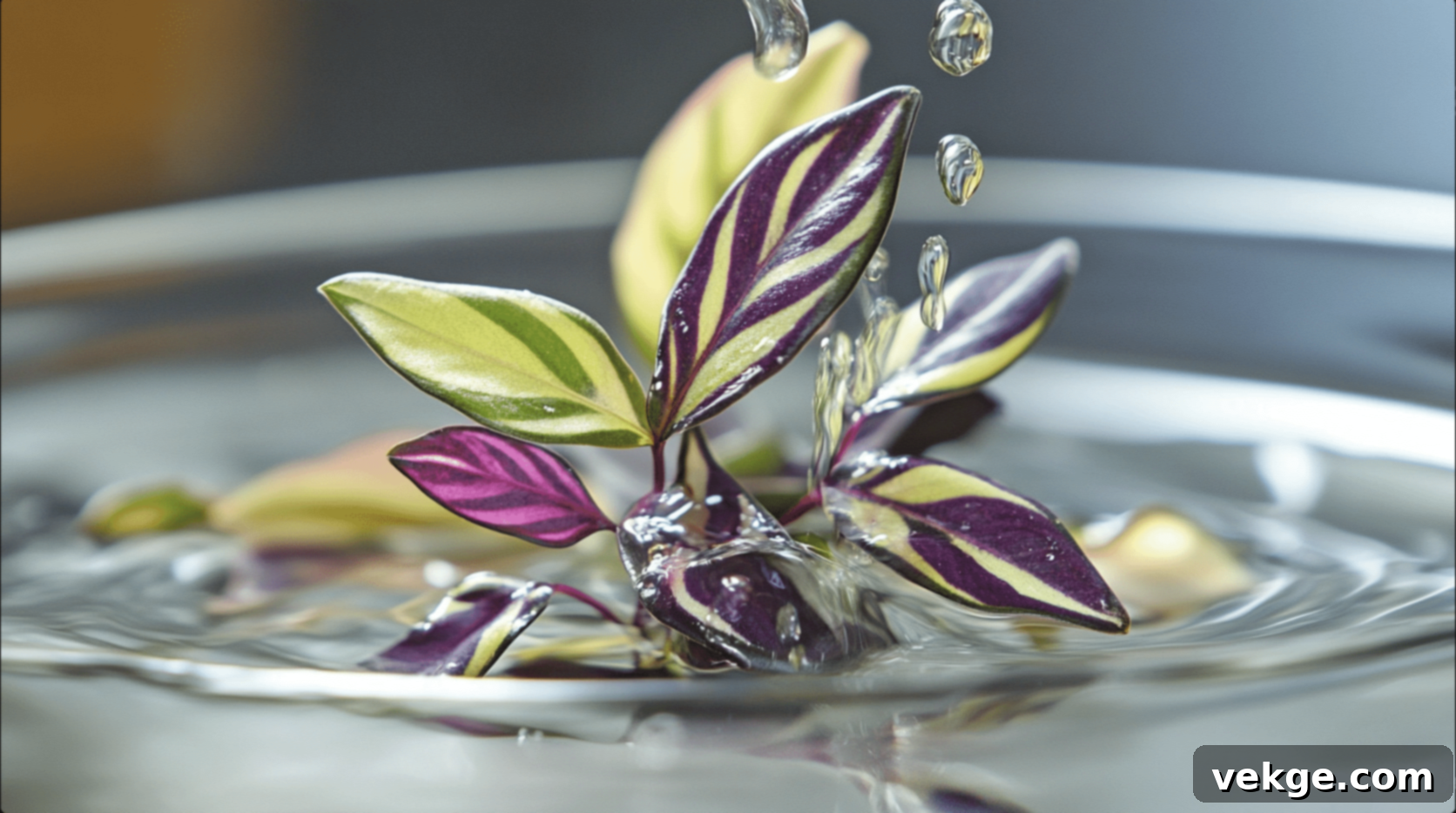
Water propagation is a fantastic visual way to watch your new plant roots develop:
- Take a Cutting: Select a healthy, vigorous stem and use clean, sharp scissors or pruners to cut a section approximately 4 to 6 inches long. Make the cut just below a leaf node (the bump on the stem where a leaf attaches), as this is where new roots will emerge.
- Prepare the Cutting: Gently remove any leaves from the bottom 1-2 inches of the stem. You want only bare stem to be submerged in water to prevent rotting.
- Place in Water: Fill a clear glass or jar with fresh, room-temperature water. Place the prepared cutting into the glass, ensuring the bare stem section is fully submerged.
- Provide Light: Position the glass in a spot that receives bright, indirect light. Avoid direct sunlight, which can cause the water to heat up too much or promote algae growth.
- Change Water Regularly: Change the water every few days to keep it fresh and oxygenated. This also prevents bacterial buildup.
- Watch for Roots: Within about one to two weeks, you should start to see tiny white roots emerging from the nodes. Be patient, as some cuttings may take a little longer.
- Plant in Soil: Once the roots are a few inches long (typically 2-3 inches), your new plant is ready to be transferred to a pot with soil.
How to Propagate Tradescantia Zebrina in Soil
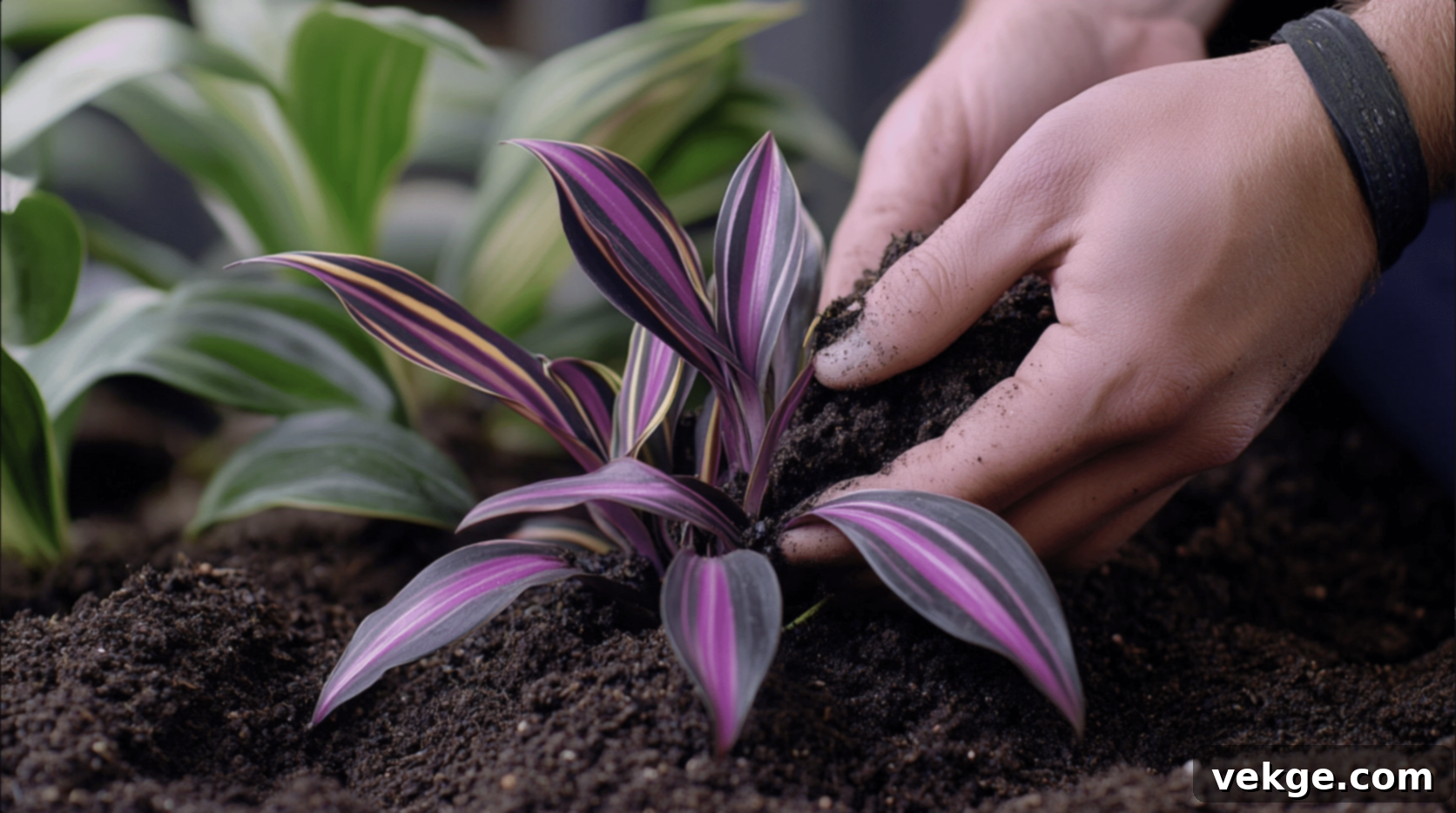
Propagating directly in soil is also highly successful and sometimes preferred for a quicker transition:
- Take a Cutting: As with water propagation, take a 4 to 6-inch cutting from a healthy stem, cutting just below a leaf node.
- Prepare the Cutting: Remove the bottom leaves, leaving only a few at the top. This prevents the buried leaves from rotting and allows the plant to focus energy on root development.
- Prepare the Pot: Fill a small pot (3-4 inches) with a well-draining potting mix, ideally a blend designed for houseplants or a mix with added perlite for aeration.
- Plant the Cutting: Use a pencil or your finger to make a small hole in the center of the soil. Gently insert the bare end of the cutting into the hole and firm the soil gently around the base to ensure good contact.
- Water Lightly: Water the soil immediately after planting until it is lightly moist but not soggy.
- Maintain Humidity and Light: Place the potted cutting in a spot with bright, indirect light. To boost success, you can cover the pot loosely with a plastic bag or dome to create a mini-greenhouse effect, increasing humidity. Remove for an hour daily to allow for air circulation.
- Wait for Growth: Keep the soil consistently moist but never waterlogged. In a few weeks, you should notice new leaf growth, indicating that the cutting has successfully rooted and is establishing itself.
How to Repot Tradescantia Zebrina
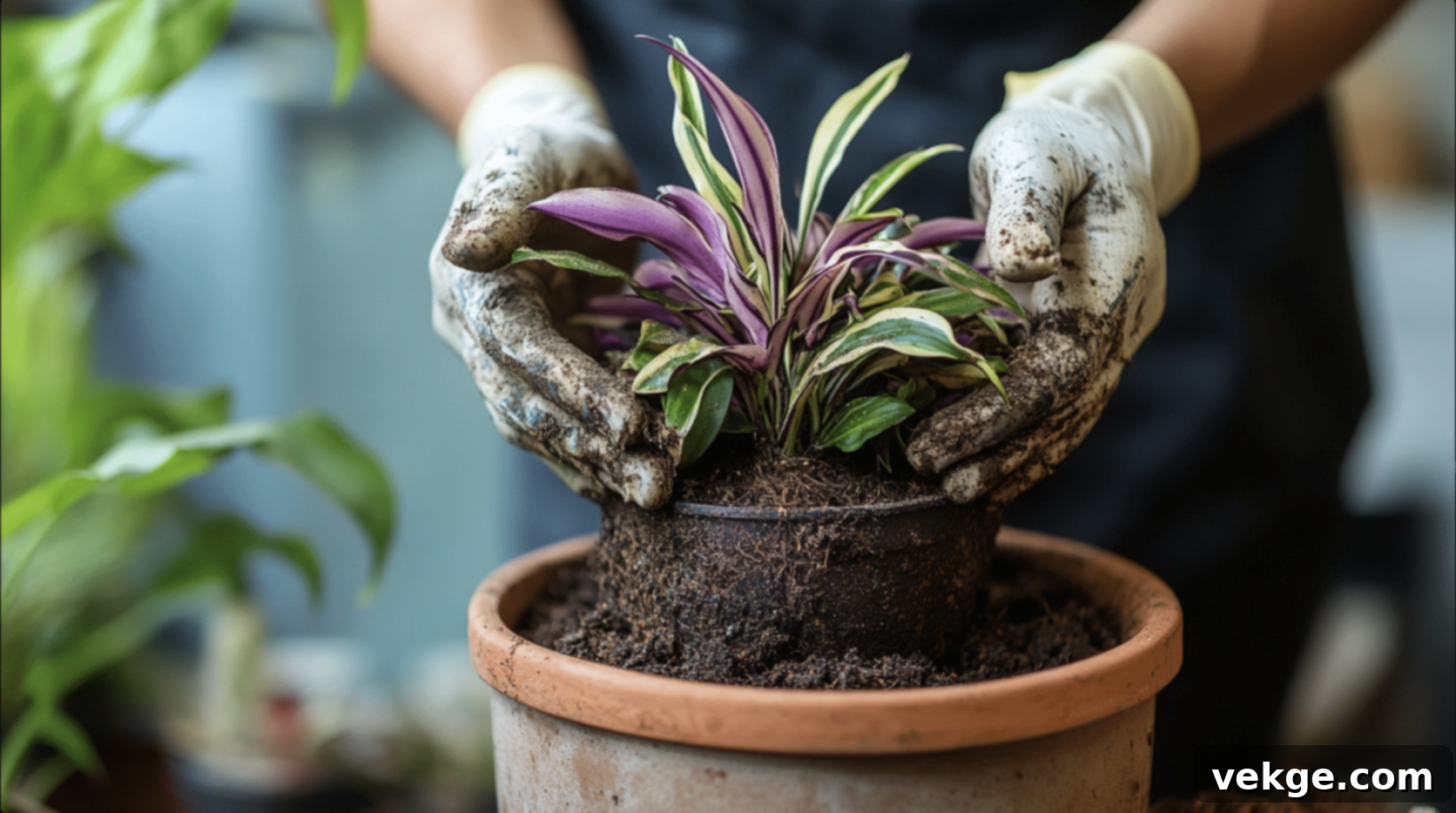
Repotting helps refresh the soil and provides more space for your growing plant. Signs your plant needs repotting include roots circling the drainage holes, water running straight through the pot without being absorbed, or stunted growth despite good care.
- Choose the Right Pot: Select a new pot that is only one size larger than the current one (e.g., from a 6-inch to an 8-inch pot). Too large a pot can lead to excess moisture retention and root rot. Ensure it has drainage holes.
- Prepare the New Pot: Add a layer of fresh, well-draining potting mix to the bottom of the new pot.
- Gently Remove the Plant: Carefully tip the old pot on its side and gently ease the plant out, trying to keep the root ball intact. You may need to loosen the soil around the edges with a knife or wiggle it gently.
- Position the Plant: Place the plant in the center of the new pot, ensuring it sits at the same depth as it was in the old pot. The top of the root ball should be about an inch below the rim of the new pot.
- Add More Soil: Fill in the space around the root ball with fresh potting mix, gently patting it down to remove large air pockets. Do not compact the soil too tightly.
- Water Thoroughly: Water the plant generously after repotting until water drains from the bottom. This helps settle the soil and reduce transplant shock.
Repot your Tradescantia zebrina every 1-2 years, or whenever it becomes root-bound. The best time for repotting is during the spring, at the beginning of its active growing season.
Fascinating Facts Related to the Inch Plant
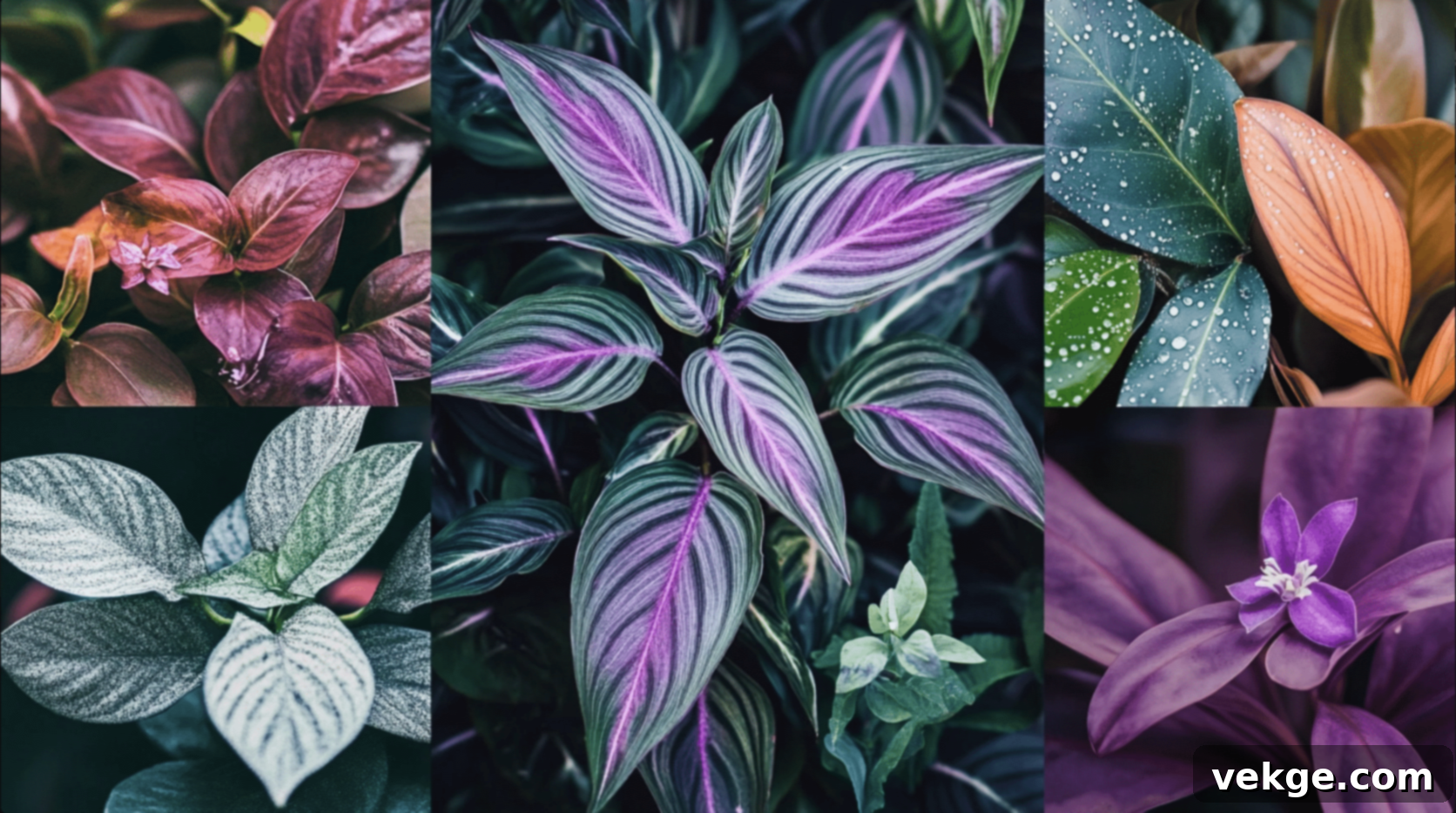
Beyond its beauty and ease of care, the Tradescantia zebrina holds several interesting characteristics that make it a truly special addition to any home. Here are some fun facts that highlight its unique charm:
- Remarkably Quick Grower: This plant lives up to its “Inch Plant” nickname with impressive speed. Under optimal conditions, you can observe new shoots and significant growth in just a matter of weeks, making it very satisfying to watch it develop and fill out a space.
- A Gardener’s Forgiveness: Often described as a “tough plant,” the Tradescantia zebrina is incredibly resilient. It can tolerate occasional neglect, such as forgotten waterings, and often bounces back readily. This forgiving nature makes it an excellent choice for beginner plant owners or those who travel frequently.
- A Modest Air Purifier: Like many indoor plants, Tradescantia zebrina contributes to healthier indoor air quality by absorbing some common airborne toxins. While not a top-tier air purifier, it plays a small role in creating a fresher home environment.
- Intriguing Stem Colors: The stems themselves are often just as colorful as the leaves, ranging from bright green to deep purple. These vibrant stems add another layer of visual interest, especially as they cascade downwards.
- Delicate Tiny Flowers: While primarily grown for its foliage, the Inch Plant can occasionally produce small, charming flowers. These delicate blooms typically feature three petals and appear in shades of pink or purple, adding a subtle touch of unexpected beauty.
- Botanical Naming Origin: The genus name, Tradescantia, honors John Tradescant the Younger, a renowned 17th-century English naturalist and gardener. He was instrumental in introducing many new plants to English gardens.
- A Plethora of Common Names: Reflecting its widespread popularity and unique growth, this plant is known by many names globally. Besides Inch Plant and Wandering Dude, other common names include spiderwort, striped wandering Jew, and purple queen (though the latter is more often used for Tradescantia pallida).
- Versatile Outdoor Application: In warm, frost-free climates (USDA Zones 9-11), Tradescantia zebrina is often utilized as a vibrant ground cover in gardens, creating lush carpets of colorful foliage that quickly spread.
- Rapid Root Development: If you propagate cuttings in water, you might be amazed at how quickly roots begin to form, sometimes in as little as three to five days. This rapid rooting makes propagation a highly successful and gratifying experience.
- Naturally Collaborative Growth: In its native habitat, these plants often grow in dense clusters, forming beautiful, living tapestries on the forest floor. This natural tendency to grow in groups enhances their visual impact when cultivated in hanging baskets or wide containers.
These fascinating aspects collectively underscore why Tradescantia zebrina is not merely a pretty plant, but an engaging and popular species that brings dynamic beauty and character into homes worldwide.
The Bottom Line
In conclusion, the Tradescantia zebrina is an exceptionally rewarding houseplant that truly embodies ease of care coupled with stunning visual appeal. Its vibrant, striped leaves and graceful trailing habit make it a captivating addition to any indoor space, whether displayed in hanging baskets or on a high shelf.
To ensure your Inch Plant thrives, remember its key preferences: bright, indirect light is crucial for maintaining its striking colors, and consistent watering when the top layer of soil feels dry will keep it hydrated without risking root rot. Provide it with a warm environment and a touch of humidity to mimic its native tropical home. Its fast-growing nature means that occasional pruning will be necessary to encourage a bushy, full appearance, and these cuttings offer a fantastic opportunity to easily propagate new plants in either water or soil.
Moving forward, embracing respectful names like Inch Plant or Wandering Dude not only celebrates its unique characteristics but also fosters a more inclusive and welcoming community for all plant enthusiasts. If you are seeking a low-maintenance plant that delivers high visual impact, the Tradescantia zebrina is an unbeatable choice.
Add this resilient and beautiful plant to your home, enjoy watching it flourish, and let its unique charm and vibrant foliage brighten your living space. It truly is a perfect plant for both new plant parents and seasoned experts alike.
Frequently Asked Questions (FAQs) About Tradescantia Zebrina
Does the Tradescantia Zebrina Prefer Sun or Shade?
Tradescantia zebrina thrives best in bright, indirect sunlight. While it can tolerate partial shade, too little light can cause its vibrant leaf colors to fade and the plant to become leggy. Direct, harsh sunlight should be avoided as it can scorch the leaves.
What Is the Typical Lifespan of the Tradescantia Zebrina?
With proper care, a Tradescantia zebrina typically has a lifespan of about 2 to 3 years. However, due to its vigorous growth and ease of propagation, many plant owners continuously refresh their plants by taking cuttings and rooting new ones, effectively extending the “life” of their plant collection indefinitely.
How Can I Make My Inch Plant Bushier?
To encourage a bushier and fuller growth habit, regularly pinch off the tips of the stems, just above a leaf node. This practice, known as “pinching,” stimulates the plant to branch out from the point of the cut, resulting in a denser, more compact appearance rather than long, leggy stems. You can also plant multiple cuttings in the same pot to achieve a fuller look.
